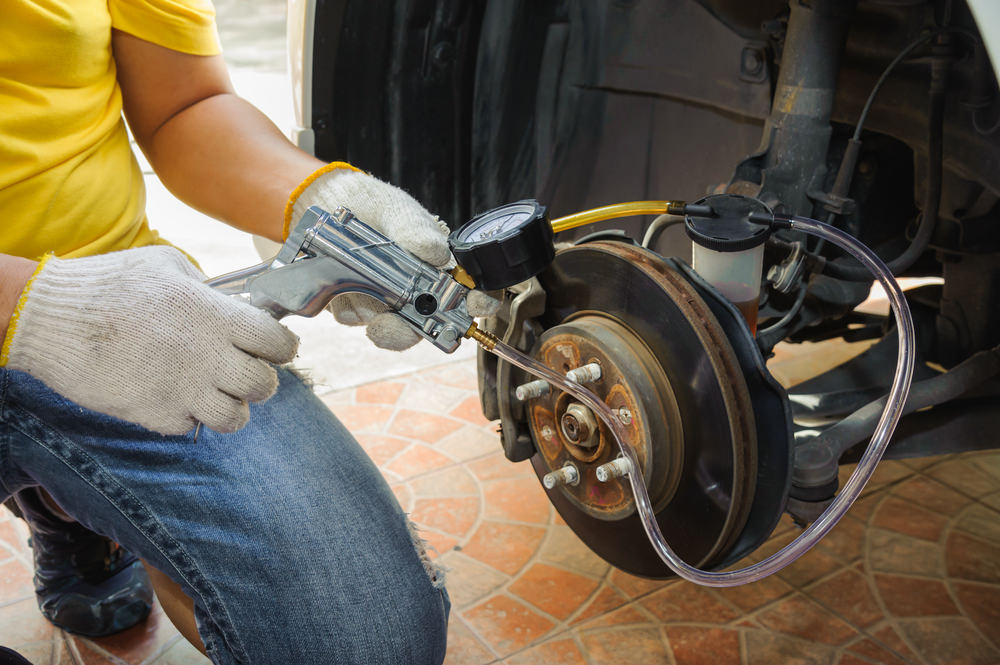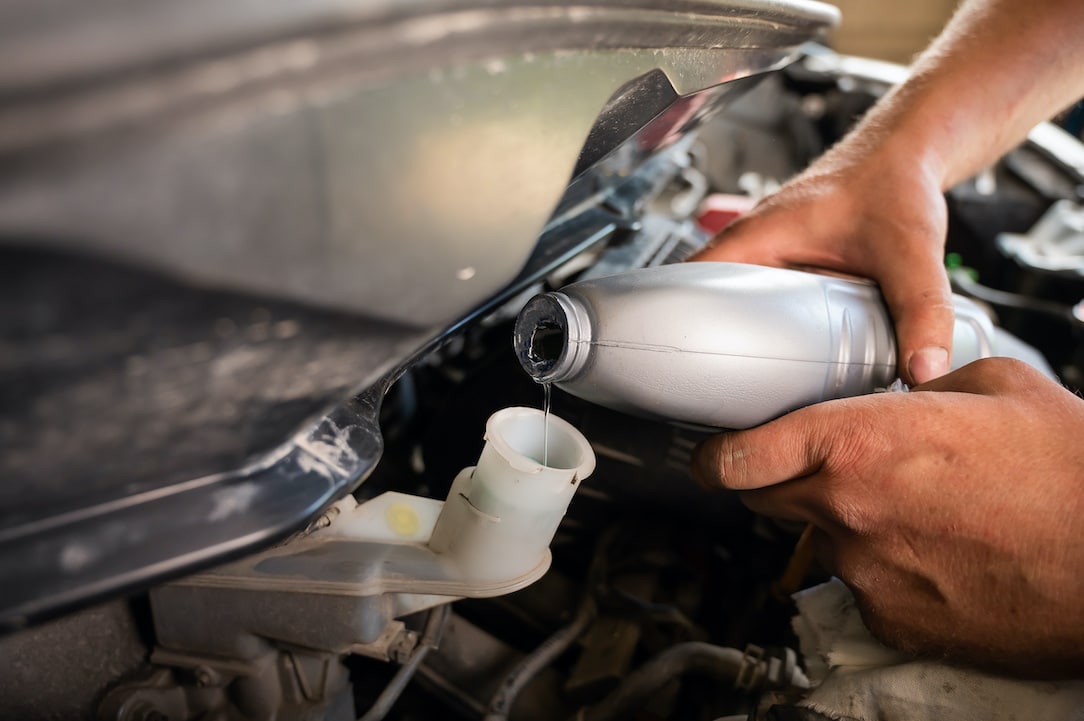What You’ll Need
For this DIY project, the below list of required supplies should cost you less than $250 and everything you’ll need is available at most auto parts stores and big-box retailers.
- Jack and jack stands to lift and secure your vehicle
- Lug nut wrench to remove your wheels
- Wrench set to remove your brake calipers (optional)
- Facemask, safety goggles and gloves to protect you from chemicals and fumes
- Brake cleaner: 3-4 cans
- Brush with stout bristles
- Sandpaper: 320-400-grit
- Acetone or mineral spirits
- Painter’s tape, plastic sheeting and aluminum foil for masking surrounding parts
- High-temperature spray paint: 3-4 cans
- High-temperature clear coat: 3-4 cans
Caliper Removal Is Best
For the best results, we recommend removing the calipers from the vehicle. This additional step offers several advantages:
- Better Coverage and Finish: It will allow you to fully access all surfaces of the caliper for a more even and thorough coat of paint.
- Cleaner, More Controlled Work Environment: Removing the calipers from the car makes it easier to properly clean the calipers and reduces the risk of getting dirt, dust or contaminants on the calipers while painting.
- Avoiding Overspray and Damage: Removing the calipers also eliminates the risk of getting accidental overspray on other components like the rotors, brake pads and suspension parts.

If you do remove the calipers, avoid painting the caliper’s inner surfaces, which can affect their function. If brake fluid is lost during the removal and reassembly processes don’t forget to top it off before driving the vehicle.
Protect Yourself
Remember, when spray painting anything, always ensure you're working in a well-ventilated area to avoid inhaling harmful fumes. Additionally, wear protective gear such as a mask, gloves and safety goggles to prevent exposure to chemicals.
Painting Calipers On the Car
.jpeg?width=312&height=208&name=AdobeStock_408898010%20(1).jpeg) You can paint your brake calipers without removing them from the car, however, getting great results requires a bit more care and attention to detail. This method requires the additional step of carefully and completely masking off everything you don’t want to paint with newspaper or plastic sheeting to catch any overspray, including the brake rotor, brake lines, brake pads, wheel well, suspension and surrounding bodywork. And unless you want your driveway or garage floor to match your calipers, don’t forget to cover the ground.
You can paint your brake calipers without removing them from the car, however, getting great results requires a bit more care and attention to detail. This method requires the additional step of carefully and completely masking off everything you don’t want to paint with newspaper or plastic sheeting to catch any overspray, including the brake rotor, brake lines, brake pads, wheel well, suspension and surrounding bodywork. And unless you want your driveway or garage floor to match your calipers, don’t forget to cover the ground.
To mask properly on all four brakes, you’ll need several rolls of painter’s tape. Use it liberally to secure your coverings, especially if you’re painting outside—you don’t want the newspaper or plastic sheeting flapping in the wind.
For brake lines and other small, hard-to-mask components, wrapping them with aluminum foil is a masking trick that’s quick to apply and easy to remove.
Prepare the Surface for Paint
Whether you’re painting your calipers on or off the vehicle, they must be prepared properly, and that begins with a comprehensive cleaning:
.jpeg?width=321&height=214&name=AdobeStock_132587005%20(1).jpeg)
- Use brake cleaner to remove any grease, dirt and brake dust.
- Scrubbing with a stiff brush will make quick work of clearing dirt and oil from the surface.
- Follow up with soapy water and a thorough rinse.
- Dry everything with a clean microfiber towel.
Next, use 320-grit to 400-grit sandpaper to scuff the area you’ll be painting, including all the small grooves and nooks that make up the caliper’s shape. This creates a slightly textured surface that helps the paint bond more effectively, reducing the risk of peeling or chipping later.
Then apply acetone or mineral spirits to eliminate any leftover sanding debris and brake cleaner; both can have adverse effects on the paint you’ll be applying.
Only Use High-Temperature Paint
To create your ideal custom finish and long-lasting results, you can’t use standard spray paint. It isn’t formulated for the extreme temperatures produced by your brake system and will begin to fade and flake off after a few days of driving.
 You need a high-temperature paint rated to withstand at least 500°F. There’s an endless range of colors available. Some paint brands even offer brake caliper-specific paint, designed to resist the caustic properties of brake dust.
You need a high-temperature paint rated to withstand at least 500°F. There’s an endless range of colors available. Some paint brands even offer brake caliper-specific paint, designed to resist the caustic properties of brake dust.
Most high-temperature and caliper-specific paints are self-priming, though you should refer to the manufacturer’s instructions before beginning. If a primer coat is needed, high-temperature versions are also readily available. If you want a higher gloss finish that maximizes durability, apply a high-temperature clear coat.
If you run into trouble or aren’t sure exactly which supplies or paint is best for your vehicle’s calipers, our Tinker experts are here to help. If you follow these steps, together with a little patience and attention to detail, your freshly painted calipers will stand out aesthetically and help fend off corrosion for years to come.
.jpeg?width=398&height=265&name=AdobeStock_135488359%20(1).jpeg) You see a set of red or yellow performance brake calipers and wonder how you can add that flair to your own vehicle. Well, painting your brake calipers is an easy, affordable way to add a pop of color behind your wheels for a customized, performance-inspired look. It’s also a great way to visually revitalize aging, discolored calipers while protecting them against further corrosion.
You see a set of red or yellow performance brake calipers and wonder how you can add that flair to your own vehicle. Well, painting your brake calipers is an easy, affordable way to add a pop of color behind your wheels for a customized, performance-inspired look. It’s also a great way to visually revitalize aging, discolored calipers while protecting them against further corrosion.



